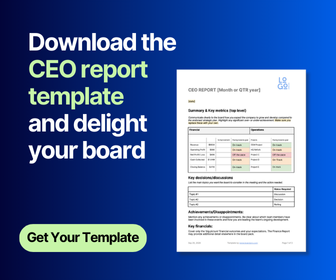Seven costly mistakes of today’s board packs and how to fix them
As a collection of documents and reports offering insights and critical information to board members before upcoming meetings, an effective board pack holds immense power in driving constructive, fruitful conversations.
If you feel like your board has spent a lot of time and effort on board packs, but your discussions still aren’t as productive as you would like them to be, it may be worthwhile to review the structure and contents of your board packs.
In this guide, the BoardPro team will discuss the seven common but costly mistakes that you could be making in your board packs and how you can solve these issues.
The seven costly mistakes
1. Prioritising information over insightThe executives writing board papers are experts in their fields. Therefore, it can often be tempting and easy to demonstrate mastery of the topic by including a lot of information. While this does help cover a lot of ground, it fails to pinpoint the essential insights. So when producing board packs, be sure to tone down the unnecessary information and include the key insights for board members.
2. Reporting just for the sake of it
Board packs for recurring agendas can quickly become routine, with just a few details or figures changed in the reports. Over time, these reports can become disconnected from the new, broad questions that the board needs to answer. So instead of asking, “what sections need to be updated since the last meeting?” executives should ask, “what is on the board’s mind that I can clarify with the information?”
3. Too retrospective
Papers that focus too much on backward-looking information only tell half the story. Boards need to consider future risks and opportunities, just as it is important to review past performance. Therefore, when writing your following board packs, remember to include information about forecasts and goals rather than focusing on past data alone.
4. Too lengthy
With so many responsibilities and topics to cover in a board meeting, it can be easy for boards to be blinded by the volume of information and miss the important bits. Most board members just spend a few hours going over board packs before meetings, so if a report is too long, the information will likely go unread.
5. No clear outline of the material
A board pack without an executive summary is a board pack without a sense of guidance. And as a result, board members, and particular non-executive directors, don’t have a clear idea of what they are receiving in each report. Therefore, including an executive summary at the beginning of the board pack will help board members get a clearer picture of the report's purpose and the meeting.
6. No clear ask
One of the purposes of a board pack is to inform board members and ask for their recommendations. When board members read your information and insights, the next thing they will want to know is, “what is needed from me?” Therefore, it is a great idea to include explicitly what you need and want from the readers, as it will clear up and prevent any misunderstandings or confusion.
7. Not enough strategic discussion
Strategy is an essential focus of any board, yet board packs often lack strategic insight and rarely cover the options considered and options rejected. Without including this critical information, It is difficult for boards to have practical strategic discussions or challenge decisions if they have only the conclusions to work with.
So what?
These seven mistakes appear more often than they should. So what are their impacts?
In some industries, small charities devote dozens of days every year to producing their board packs. This takes up substantial amounts of time and money. But still, two-thirds of organisations assess their packs as being “weak” or “poor” overall.
So how can your organisation improve your board packs to ensure your efforts don’t go to waste? Here are a few simple ways to amend your reports to stimulate fruitful conversations.
5 simple solutions to board pack success
An effective board pack should accomplish the following two tasks: drive strategic conversations and allow your board to make well-informed decisions. So if your board pack doesn't do those two things, your organisation is not taking advantage of the full potential of its board. Whether it’s the contents of your board reports or the board pack creation and review process, there are several key aspects you can improve to turn your board pack into the powerful tool it is supposed to be.
Problem 1: information over insight
When writing a board paper, the authors need to place themselves in the shoes of board members. The board is not just looking for an update of what has been happening over the last period. Instead, the board wants to know the “why?” and the “so what?”
Solution: report writing training and report briefing
Great board papers cover the context, facts and figures concisely and focus their attention on the factors driving the results and what it all means for the organisation. However, we understand that this is easier said than done, and not everybody has been trained in writing or presenting data holistically and succinctly in a business context. Thus, short training courses that cover how to structure information, sprinkled with journalistic tips and tricks, can make a world of difference.
Once you are ready to begin putting together your board report, make sure that your board pack writers undergo a briefing process. First, have the writers sit down with their paper sponsor and agree on the brief. During this process, it is imperative to define the purpose of the paper and the high-level questions it needs to address. Then when the report writers are clear on what the questions are that the board needs to have answered, they can structure their reports around the purpose and these questions, ensuring that the papers are focused on what matters most and contain the most relevant information.
Problem 2: Too retrospective
Of course, it is important to acknowledge and discuss relevant metrics, but it is equally essential that at some point, the discussion moves forward to outline the next steps.
Solution: Ask the right questions
Many report writers are comfortable reporting backward-looking information like financial metrics and KPIs. But to create a board report that lives up to its potential, report writers need to discuss the next steps and future opportunities. What are the underlying drivers of the business? What might happen soon?
- The drivers of the business and the results and their impacts and significance going forward
- The risks and opportunities that may arise and how the board should handle them
Discussing these topics will help instil confidence in your board members, as they will understand the important retrospective information and have sufficient forward-looking information to make effective decisions.
Problem 3: too lengthy
According to research, the average board pack is around 288 pages long. However, board directors only spend around a few hours reading their packs before meetings. This suggests that only about 100 pages are looked over in the available time.
Solution: set a page limit
Normally, three to five pages should be sufficient for almost any topic. More specifically, we recommend being specific about the length allowed for each paper.
In fact, did you know that some boards will automatically reject any paper that surpasses the page limit? So if you can combine a stringent page limit with a clear, rigorous brief to help report writers focus on the right questions, boards can avoid missing out on critical information. With that said, if the topic is particularly complex and extra pages are inevitable, speak to the board’s chair and agree on the report length to avoid 50+ page reports.
Problem 4: no clear idea of materiality or the input required
One of the most recurrent issues arising from board packs is a lack of clarity on the materials. In other words: There is no clear statement or understanding of “why is this report in front of me, and why does it matter to the board?”
Solution: better executive summaries
An easy solution is to include an executive summary, as it can clearly state the paper's purpose. An effective executive summary should answer the following questions for its readers in a single page:
- Why are they reading the paper?
- How significant is the issue?
- What main questions does the report address?
- What are the main conclusions of the report?
- What are the readers expected to provide?
We recommend following a template to ensure the board consistently receives high-quality executive summaries from your board packs. When written well, an executive summary becomes one of the most critical parts of your board paper. In fact, asking a report writer to begin the writing process by drafting the executive summary is a great way to check that the brief is properly understood and has a straightforward structure before time is spent writing the body of the paper.
Problem 5: not enough strategic discussion
Board meetings cover many important topics, and sometimes it can be challenging to prioritise the topics. So it is important that all board members understand the agenda and the strategic focus before the meeting even starts.
Solution: get decision and discussion papers on the agenda
This is really two solutions in one. The first is to be stern about your planning and begin each meeting by discussing the most strategically important topics, so everyone debates these when they are feeling fresh and energised. The most effective boards map out their key discussions six to 12 months ahead and ensure time is safeguarded for those items, so sticking to the plan will help with prioritising strategic discussions, even when there are urgent distractions.
The second solution is to require a clear and concise decision paper to accompany any new strategic discussions that arise so that everyone really understands the main issues before the meeting begins. An excellent way to do this is to plot out the decision criteria that matter to the board and ensure report writers focus on answering those questions.
Conclusion
Now that you are on your way to a better, more effective board pack, the next question is: what does best practice look like in an organistion? If you would like to discuss any of the solutions above or see how BoardPro could help your organisation get the most from its board packs, get in touch with us here.
Share this
You May Also Like
These Related Stories

Difference between chair and CEO

More Productive Board Meetings


